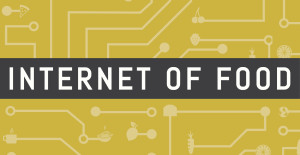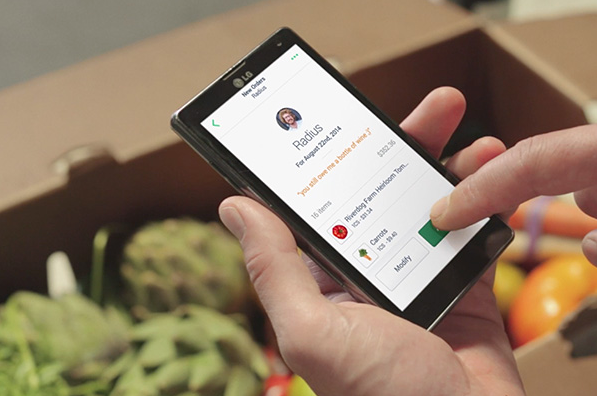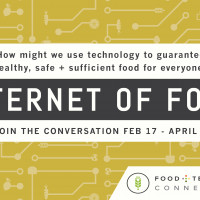Guest post by Peretz Partensky, co-founder of Sourcery. The views expressed here are solely those of the author and do not reflect the views of Food+Tech Connect.
Food cultures and technology have always been intimately linked. We used technology to grow tomatoes in winter and peas in the fall. We used technology to develop our current food system, which maximizes for calories and efficiency through centralization. Centralization has benefits, but it also means we can’t have a say in what we eat or where it comes from.
Today’s technologies can finally tackle the least transparent part of our food system: the supply chain.
The locavore and organic movements are often seen as elitist and expensive, but in the distant past, everything was local. It was only with the advent of modern technologies – transportation, refrigeration, and new crops – that we gained access to a variety of food in all seasons and climates. Centralized distribution systems made it possible for producers to specialize in one product, which they could then raise with maximum efficiency. This lowered prices for the consumer, but it came with a hidden cost.
Our current, centralized system is efficient and inexpensive. It is also opaque. How and where your produce is grown is extremely difficult to track. The system developed to move large orders of homogenous products, not to maximize for the health of produce, consumers, farms or the environment.
Sourcing is especially hard for restaurants, which deal with multiple suppliers. According to the National Restaurant Association, Americans spend $709.2 billion dollars in restaurants every year or 47 percent of the food dollar. Helping restaurants control their sourcing is key to changing the way our supply chains works. Finding local, responsible producers who chefs trust may not add significantly to the cost of a single tomato order, but the overhead in terms of time at scale makes it extremely expensive.
A restaurant that accepts whatever produce is offered them, without asking questions, can meet almost all of their needs through three or four vendors.
In comparison, a restaurant in the farm-to-table model may have to pay 100 invoices a month from 15 different suppliers, each operating on different payment terms.
Foodservice businesses are incentivized to consolidate back of house operations. They cut back on ingredients and the number of suppliers they order from, even when local farms are available. A restaurant in Sacramento could end up buying produce from the farm next door without even knowing it, only to have it sent to a distributor in San Francisco and hauled all the way back. In the centralized model, the logistical cost at scale trumps all others.
A number of things are coming together to make tracking and selecting our food easier.
First, a growing desire for transparency is motivating more consumers to seek out the food they want. Consumers want information about where their food comes from and how it was produced, so they can make informed decisions. Transparency, quality, and value are important. Food producers and distributors are beginning to see that transparency is marketable.
At the same time, technology is making new, decentralized business models possible. Disruptive technology is reducing the cost of many loosely connected parts. Sourcery lowers the cost to restaurants of sourcing their food from a variety of producers. Sourcery connects restaurants with their local farms and handles the entire overhead – a kitchen can order from 100 suppliers, but they’ll only have to pay one invoice.
Our modern food system involves a complicated supply chain, but we have the technology to make sure the healthy choice is also the easy, affordable choice.
 Internet of Food is editorial series exploring how we might use technology, new business models and design to guarantee healthy, safe and sufficient food for everyone. Join the conversation between February 17 and April 2. Share your ideas in the comments, on Twitter using#internetoffood, Facebook or LinkedIn.
Internet of Food is editorial series exploring how we might use technology, new business models and design to guarantee healthy, safe and sufficient food for everyone. Join the conversation between February 17 and April 2. Share your ideas in the comments, on Twitter using#internetoffood, Facebook or LinkedIn.
___________
 Peretz is the Co-Founder of Sourcery. Sourcery’s mission is to create economically and environmentally sustainable food ecosystems by developing products and services that improve communications and commerce between buyers and suppliers. Prior to founding Sourcery, Peretz coached a basketball team in Afghanistan, got a master’s degree in Literature from the University of Cambridge, and a PhD in Biophysics from the University of California, San Francisco.
Peretz is the Co-Founder of Sourcery. Sourcery’s mission is to create economically and environmentally sustainable food ecosystems by developing products and services that improve communications and commerce between buyers and suppliers. Prior to founding Sourcery, Peretz coached a basketball team in Afghanistan, got a master’s degree in Literature from the University of Cambridge, and a PhD in Biophysics from the University of California, San Francisco.






